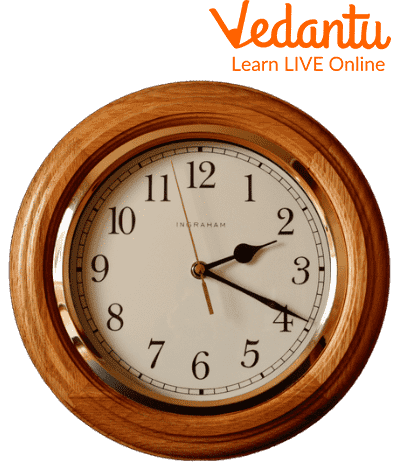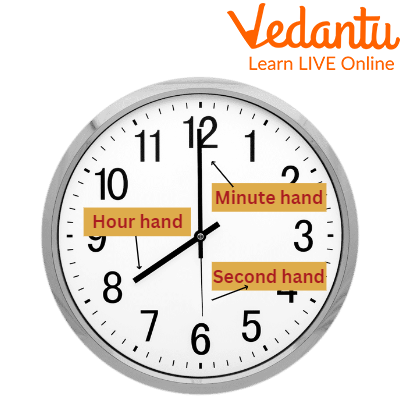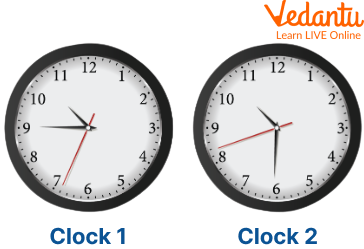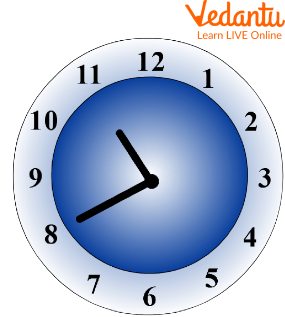




Introduction to Time
Time seen through an analogue clock or a digit clock has to be understood correctly. For the first instance, children find it difficult to understand time. Two prime reasons for the difficulty in understanding time are that the time is the same two times in a day, and the unit of time is made of 60 units, unlike other units of 10 or 100 units.
Adding to this challenge are two-time formats for math, a 12-hour format and a 24-hour format. Time has units of hours, minutes, and seconds and is expressed in AM (Anti Meridian) or PM (Post Meridian). Further, let us check the below content to know more about reading time by looking at the hands of the clock.
What are Clocks?
A clock normally displayed in a room or connected to a wall displays the time. You can see clocks of different sizes around you. Some clocks show only time, whereas others show temperature, date, weather, etc. Also, some clocks have a stopwatch, and some have alarms.

The Clock
Parts of Clock
The two widely used clocks are the analogue and digital clocks. Both clocks have different ways of representing time.
What are Analogue Clocks?
A clock is known as an analogue clock when it has moving hands and is usually (hours) marked from 1 to 12 to show you the time of the day.
In some analogue clocks, hours are marked with Roman numerals (such as I, II, III, IV, etc.), while in others, no numbers are marked in the clock.
Minute Hand
The hand on a clock or watch that displays the minutes is called a minute hand; it is typically longer than the hour hand. The large hand indicates the minutes on a clock. It completes one full circle every 60 minutes (one hour). For instance, the minute hand is just past the number " 4 " on the clock on the left, and by counting the small markers starting at " 12," you can see that it is 22 minutes past the hour. (The "hour hand" on the little hand is barely past eight, making the time 22 past eight).
Hour Hand and Minute Hand
Following is the difference between the hour hand and the minute hand:

Hour hand and Minute hand
What are Digital Clocks?
Digital clocks are one of our society's most common pieces of technology. The electronic wristwatch has experienced major evolutionary changes and dozens of offshoots, including everything you could imagine cramming into a wristwatch.
Uses of Clocks
Following are the uses of the clocks:
A watch is a device used to measure, verify, keep, and indicate the time.
A clock is one of the oldest human inventions, which meets the need to measure shorter time intervals than natural units like the day, the lunar month, and the year.
It helps to maintain discipline among the people.
Solved Example
Q 1. Ram and Shyam are playing the game "Clock". Ram must check the time on the provided clock. When he saw the clock, what time should he say?

Time
Ans: The hour hand is at 10, indicating 10 hours. The minute hand is at 1. Let's calculate minutes: 1 × 5= 5. Therefore, the time is 10:05.
Q 2. Ram is given two photos of clocks. He needs to locate the clock that reads 10:45. Which clock should he pick from the list below?

Different clocks
Ans: The hour hand of the first clock has crossed 10. The minute hand is at 9. So the time displayed by Clock I is 10:45. The hour hand of Clock II is at 10. The minute hand of clock II is at 6. Then the time displayed by Clock II is 10:30. Therefore, Clock 1 shows 10:45.
Practice Problem
Q 1. Shivam wants to set the clock at 6:15. Which hand should point at 6?
Ans: Hour hand
Q 2. Ram looks at a clock with the minute hand at eight and the hour hand between ten and eleven. He is interested in the time. What will it show?

Time
Ans: 10:40
Summary
We saw that the clock has three hands, second, minute, and hour hand. The hour hand indicates an hour. The big hand, i.e. minute hand, indicates the minute, so in whichever number the big hand is pointing, we can calculate the minute with that number. A day has 24 hours. A clock, having markings from 1 to 12, identifies all 24 hours of the day.
It's common to see clocks with Roman Numerals (I, II, III, etc.) and clocks without numbers! Rotating hands surround the clock's face. In the end, we added some practice questions and solved examples to get more clarity on the topic.
FAQs on Different Ways of Reading Time
1. What are the main ways of reading time on different types of clocks?
The two main ways to read time are using an analogue clock and a digital clock. Analogue clocks show time with hands pointing to numbers, while digital clocks display numbers directly, often in either the 12-hour or 24-hour format.
2. How do you differentiate between the hour hand and the minute hand on an analogue clock?
On an analogue clock, the hour hand is usually shorter and moves slowly to indicate hours, while the minute hand is longer and moves faster to show minutes. The position of each helps determine the exact time.
3. Why is reading time often challenging for students learning from clocks?
Reading time can be tricky because the clock uses a 12-hour cycle twice each day (AM and PM), and minutes/hours do not follow the base-10 system most numbers use, but instead use 60 units for an hour. Understanding both hand positions and the switch between 12-hour and 24-hour formats adds to the difficulty.
4. What do AM and PM mean in the 12-hour clock format?
AM stands for Ante Meridiem (before midday), representing times between midnight and noon. PM stands for Post Meridiem (after midday), representing times from noon to midnight. This helps distinguish between morning and evening times.
5. How does the 24-hour clock differ from the 12-hour clock system?
The 24-hour clock system counts hours from 0 to 23 without repeating numbers or using AM/PM, while the 12-hour clock uses numbers 1 to 12 twice, distinguished by AM or PM. For example, 1 PM in 12-hour format is written as 13:00 in the 24-hour format.
6. What are Roman numerals on clocks, and why are they used?
Some analogue clocks use Roman numerals (I, II, III, etc.) instead of Arabic numbers. They are traditional and often seen in classic clock designs, adding uniqueness and sometimes helping students recognize numerals in both formats.
7. Explain the importance of learning to read both analogue and digital clocks in daily life.
Knowing how to read both analogue and digital clocks is practical for managing daily routines, attending events on time, and using devices like watches, alarms, and school bells. It strengthens basic time-telling skills and helps with scheduling and discipline.
8. Who introduced the 24-hour time system and what was its original purpose?
The 24-hour time system was introduced by Hipparchus, who divided the day into 24 equinoctial hours to accurately measure daylight and night on equinox days. This system allowed for precise timekeeping throughout the full day.
9. What common mistakes should be avoided when reading time, especially on analogue clocks?
Avoid confusing the hour and minute hands, miscounting by not starting from 12 for minutes, and not considering if the time is AM or PM. Always check which hand is longer and shorter, and count in multiples of 5 for each minute marker on the analogue clock.
10. How can understanding the concept of time help students in managing their studies and daily routine?
Understanding time enables students to plan study schedules, submit assignments on time, attend classes punctually, and develop time management skills. This skill is essential for exam preparation and building habits for lifelong success.











